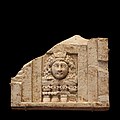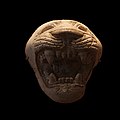Arslan Tash
 | |
| Location | Syria |
|---|---|
| Region | Aleppo Governorate |
| Coordinates | 36°50′55″N 38°24′28″E / 36.84861°N 38.40778°E |
Arslan Tash (Turkish: Arslan Taş "Lion Stone"), ancient Hadātu, is an archaeological site in Aleppo Governorate in northern Syria, around 30 kilometres (19 mi) east of Carchemish and the Euphrates and nearby the town of Kobanî.
History
[edit]The city was the center of an Aramean Iron Age kingdom, which was conquered by Assyria in the 9th century BC. The site includes a Late Assyrian palace, an early shrine to Ishtar and a Hellenistic temple, surrounded by city walls and gates adorned with lions carved from stone.[1]
Archaeology
[edit]
The site of Arslan Tash was first examined in 1836 by an expedition led by Francis Rawdon Chesney.[2] The first actual excavations were conducted by the French archaeologist François Thureau-Dangin for the Louvre Museum in two short seasons during 1928. It worked on the fortifications, a Hellenistic period temple, a temple to Ishtar, the "Bâtiment aux ivoires" and late Assyrian remains.[3]
In 2007 and 2008 work at the site resumed when surveys were conducted by a team from University of Bologna and Directorate-General of Antiquities and Museums of the Syrian Arab Republic. The team was led by Anas al-Khabour and Serena Maria Cecchini. Each season lasted about a week, with the later one including geophysical work. [4]
Gateway reliefs
[edit]The Arslan Tash reliefs are bas-reliefs of people and animals on the gates of the city and temple. The dating of the reliefs is uncertain, though one contains an inscription of Tiglath-Pileser III of the Neo-Assyrian Empire[5]
In February 2015, in the Syrian city of Raqqa, the Islamic State of Iraq and the Levant (ISIL) publicly ordered the bulldozing of a colossal ancient Assyrian gateway lion sculpture from the 8th century BC.[6] Another lion statue was also destroyed. Both statues originated from the Arslan Tash archaeological site.[7] The destruction was published in the ISIL magazine, Dabiq.
Ivory items
[edit]-
The woman at the window, tree of life, lion, and suckling bovine are common goddess symbols. The latter is Egyptian hieroglyph ams.[8]

The most important discoveries from Arslan Tash were, however, the ivory objects of high artistic quality which today are kept at the Archaeological Museum in Aleppo and in the Louvre.[9]
Among them is the Arslan Tash ivory inscription that carries the name 'Hazael'; this was part of a bed that may have belonged to the Biblical king Hazael of Aram-Damascus. The inscription is known as KAI 232.[10] See also Hazael horse frontlet.
Amulets
[edit]The Arslan Tash amulets are two limestone pieces. They were not excavated, rather purchased from an antiquities dealer, so their actual provenance is uncertain. The writing on the tablets is in Aramaic script, although the language of the inscriptions is Phoenician. The tablets were subject to extensive research over the decades, and they have provided remarkable insights into the society and religion of that period. Some scholars questioned the authenticity of these amulets.[11][12]
Gallery
[edit]-
Assyrian chariot, charioteer, and a horse rider. Basalt wall relief. From the palace of Tiglath-pileser III at Hadatu, Syria. 744-727 BCE. Ancient Orient Museum, Istanbul
-
Basalt wall slab showing Assyrian soldiers in procession, holding long spears. From the palace of Tiglath-pileser III at Hadatu, Syria. Ancient Orient Museum, Istanbul
-
Basalt wall slab showing three Assyrian soldiers in procession. From the palace of Tiglath-pileser III at Hadatu, Syria. Ancient Orient Museum, Istanbul
-
Basalt wall slab showing Assyrian soldiers in procession, holding maces and bows. From the palace of Tiglath-pileser III at Hadatu, Syria. Ancient Orient Museum, Istanbul
See also
[edit]- Cities of the ancient Near East
- Destruction of cultural heritage by ISIL
- Short chronology timeline
- Arslan Tash amulets
Notes
[edit]- ^ Geoffrey Turner, The Palace and Bâtiment Aux Ivoires at Arslan Tash: A Reappraisal, Iraq, vol. 30, no. 1, pp. 62-68, 1968
- ^ [1] Francis Rawdon Chesney, The expedition for the survey of the rivers Euphrates and Tigris, carried on by order of the British government, in the years 1835, 1836, and 1837, Longman, Brown, Green, and Longmans, 1850
- ^ F. Thureau-Dangin et al., Arslan-Tash, P. Geuthner, 1931
- ^ Serena Maria Cecchini, Fabrizio Venturi, A Sounding at Arslan Tash. Re-visiting the Bâtiment aux Ivoires, in R. Matthews & J. Curtis (éd.), Proceedings of the 7th ICAANE, 12–16 April 2010, the British Museum and UCL, London, 3, Wiesbaden, pp. 325-341, 2012
- ^ Pauline Albenda, The Gateway and Portal Stone Reliefs from Arslan Tash, Bulletin of the American Schools of Oriental Research, no. 271, pp. 5-30, 1988
- ^ Caubet, Annie. "Syrian Heritage in Jeopardy: The Case of the Arslan Tash Ivories." Journal of Eastern Mediterranean Archaeology and Heritage Studies, vol. 5, no. 1, pp. 92-101, 2017
- ^ "Lion statues destroyed". UNESCO. Retrieved 27 Feb 2015.
- ^ Goldwasser, Orly (2014-03-18). "Goldwasser, O. 2006. "Canaanites Reading Hieroglyphs. Part I – Horus is Hathor? Part II – The Invention of the Alphabet in Sinai." Ägypten und Levante 16: 121-160". Academia.edu. Retrieved 2024-01-30.
- ^ Fontan, Elisabeth, et Ina Reiche, Les ivoires d'Arslan Tash (Syrie) d'après une étude de la collection du Musée du Louvre : mise en œuvre du matériau, traces de polychromie et de dorure, état de conservation, ArchéoSciences, vol. 35, no. 1, pp. 283-295, 2011
- ^ Muscarella, Oscar White (29 January 1980). The Catalogue of Ivories from Hasanlu, Iran: Hasanlu Special Studies, Volume II. UPenn Museum of Archaeology. pp. 218–. ISBN 978-0-934718-33-2.
- ^ Jacobus van Dijk, The Authenticity of the Arslan Tash Amulets, Iraq, vol. 54, pp. 65-68, 1992
- ^ D. Pardee, "Les documents d' Arslan Tash : authentiques ou faux?", Syria 75, pp. 15–54, 1998





![The woman at the window, tree of life, lion, and suckling bovine are common goddess symbols. The latter is Egyptian hieroglyph ams.[8]](http://upload.wikimedia.org/wikipedia/commons/thumb/2/28/Ivory_plaque-AO_11454-IMG_0700-black.jpg/120px-Ivory_plaque-AO_11454-IMG_0700-black.jpg)



